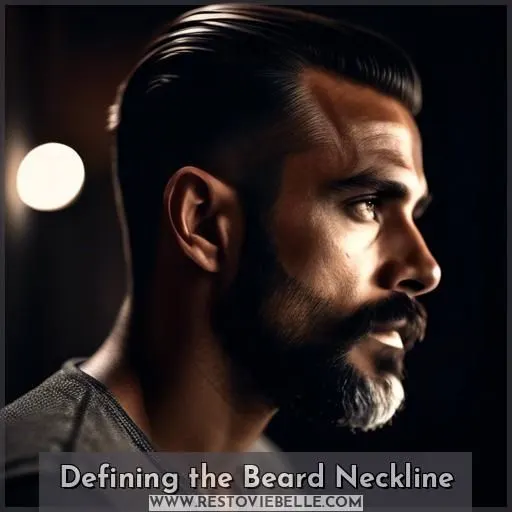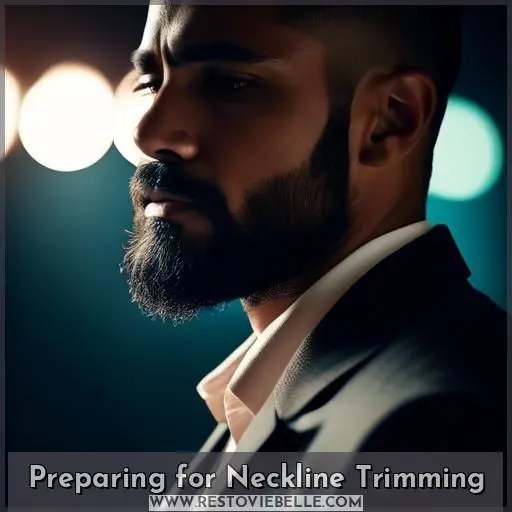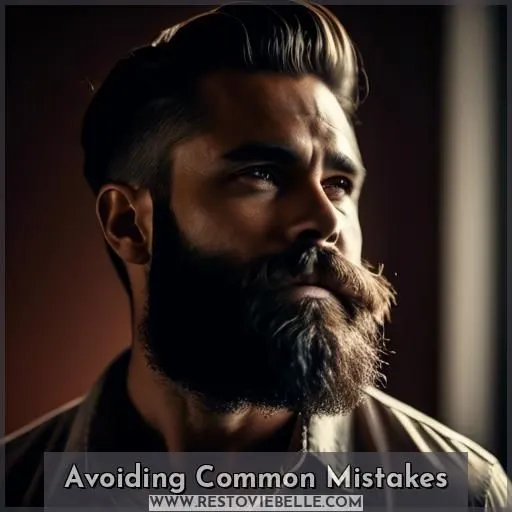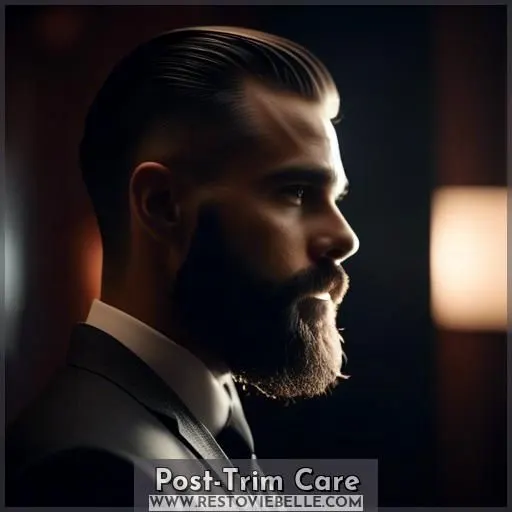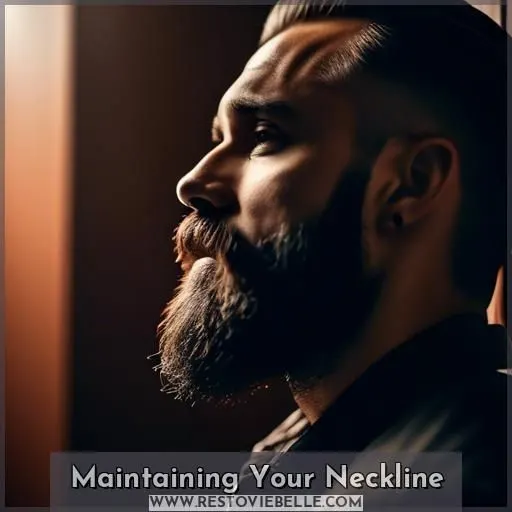This site is supported by our readers. We may earn a commission, at no cost to you, if you purchase through links.
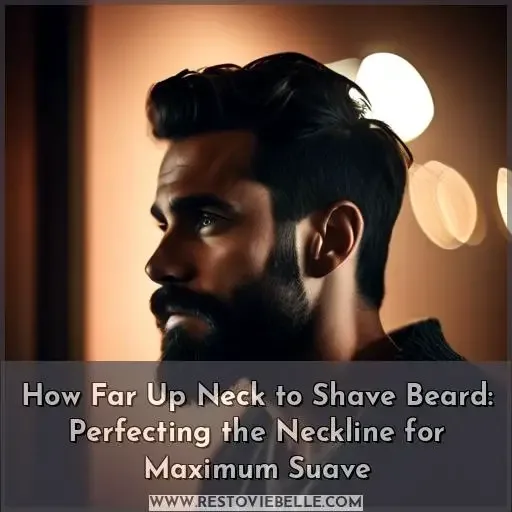
To achieve the perfect neckline, shave your beard about two finger-widths above your Adam’s apple, aligning with the area between the bottom creases of your earlobes.
This strategic placement flatters your facial features and avoids the dreaded neckbeard look.
When trimming, use sharp tools and take your time to ensure it is even.
Proper neckline grooming elevates your beard’s overall aesthetic and suave factor.
Want to learn more trimming techniques, preparation tips, and post-shave care? Keep exploring for the ultimate guide to perfecting your beard’s neckline.
Table Of Contents
Key Takeaways
- The appropriate neckline for a beard should be located about two finger-widths above the Adam’s apple, aligning with the area between the bottom creases of the earlobes.
- Softening the beard before trimming is essential for achieving a clean and defined neckline. This can be done by using beard emollients, conditioners, or oil, and applying a warm towel to the area.
- Precision is crucial when trimming the neckline. Use a neck hair trimmer with adjustable settings, and invest in quality tools to achieve a crisp, well-defined line.
- Post-trim care is important for maintaining a healthy and well-groomed beard. Apply beard balm and oil, and treat any razor burn with natural remedies like aloe vera or witch hazel.
How Far Up Neck to Shave Beard?
To shave your beard neckline, aim to trim it where your head connects to your neck, which is usually just above your Adam’s apple.
This is a general placement for your neckline.
When trimming the actual line, start at the middle of your neck and slightly curve up in the direction of your ears as you round the neck.
This is a personal preference, but in general, you want a straight line across your neck while curving up in the direction of your ears.
Remember to maintain the line until your beard grows long enough that you can’t see the neckline anymore.
Defining the Beard Neckline
Establishing the beard neckline is essential for a polished, sophisticated appearance. The neckline designates the lowest point on your neck where beard growth ceases, and its appropriate positioning not just elevates your overall aesthetic but also averts an untidy, disheveled neckbeard.
Locating the Neckline
To locate your beard neckline, place your finger at the top of your Adam’s apple and shave below this point for a clean look.
The neckline should be located at the line between the lowest points of your ears, meeting at your Adam’s apple, about two fingers above it.
This location allows for a well-defined neckline that enhances your beard style and prevents messy neckbeards.
Importance of Neckline Placement
After pinpointing your neckline, comprehending its placement’s significance is essential.
The appropriate neckline styles and shapes can metamorphose your appearance, providing a fusion of authority and intimacy.
Symmetry and angles play pivotal roles; they’re the secret formula to neckline grooming.
A neck hair trimmer emerges as your most valuable ally, guaranteeing precision.
Bear in mind, the odyssey doesn’t culminate here.
Post-trim, nurture with beard balm and oil, and maintain its pristine condition with beard and face wash.
Preparing for Neckline Trimming
Before tackling your beard’s neckline, you’ll want to soften the coarse hair by showering or applying a warm towel to the area. Proper tools are also essential; invest in a quality beard trimmer with adjustable guard lengths and edging capabilities to achieve a crisp, well-defined neckline.
Softening the Beard
Preparing for Neckline Trimming
To achieve an impeccable neckline, it’s imperative to soften your beard before trimming. Here’s how to do it:
- Employ a beard emollient: A beard emollient is a product that nourishes and hydrates your beard, making it more pliable and manageable. It can be a beard conditioner, oil, or butter.
- Condition your beard: Beard conditioners are specifically designed to soften and moisturize your facial hair, making it easier to comb and style. They contain ingredients like proteins, vitamins, and natural oils that help strengthen and repair your beard.
- Apply beard oil: Beard oil is another indispensable product for softening your beard. It penetrates the hair shaft, providing hydration and nourishment, and leaving your beard feeling soft and manageable.
- Use a beard balm: Beard balm is a leave-in conditioner that helps to soften and tame your beard, especially when combined with a beard oil.
Selecting the Right Tools
To achieve a well-groomed beard, selecting the right tools is essential. Here are some tips on how to prepare for neckline trimming:
- Trimming Attachments: Use precision trimming attachments for careful shaping. These attachments can help you maintain a clean and defined neckline, especially for shorter beards.
- Precision Tools: Opt for a neck hair trimmer designed for accuracy. These trimmers often come with adjustable settings, allowing you to customize the length of your beard.
- Shave Gel: Apply shave gel for hydration and skin protection. This will help your razor glide smoothly over your skin, reducing the risk of razor burn and irritation.
- Neck Razors: Choose a neck razor designed for sensitive skin. These razors are typically gentler on the skin and can help prevent razor burn and ingrown hairs.
Trimming Techniques
For a crisp, distinct appearance, select a straight neckline by grooming the hair alongside the horizontal plane beneath your jawline and generating angular points below the ears. If you favor a gentler aesthetic that enhances your facial contours, choose a rounded neckline by marginally arching the grooming line and softening the corners for a seamless shift from beard to skin.
Straight Vs. Rounded Neckline
Choosing Between Rounded and Straight Necklines: A Guide for Beard Styles
When it comes to beard necklines, the option between rounded and straight styles can have a notable effect on the overall appearance and character of your facial hair. Here are some essential points to contemplate when reaching a decision:
-
Face Shape: The outline of your face can guide which neckline style is more appealing. For instance, a round face may find a rounded neckline helpful for extending the jawline, while a square face might appear better with a straight neckline to accentuate the edges.
-
Long vs. Short Beards: Beards that are longer generally have less distinct necklines, while shorter beards can have higher necklines. Explore various styles to discover what suits the length of your beard best.
-
Angles vs. Curves: Rounded necklines establish a more natural, flowing look, while straight necklines offer a tidier, more precise appearance. Take into account your personal style and the desired effect.
-
Corner Styling: Rounded necklines can form sharper jawlines, while straight necklines can provide a more angular appearance. When shaping the corners, think about using a trimmer with a precision attachment to attain the desired style.
Trimming the Sides
To trim the sides of your beard, start at the center of your neckline and work outwards.
Use a trimmer length two levels shorter than your beard for a clean look.
For curved vs angular corners, consider using attachments that contour to your neck’s natural shape.
Always maintain a slight upward curve to avoid a round neckline.
Shaping the Corners
To shape the corners of your beard, start by trimming a vertical line below your earlobes. Then, connect this line to the horizontal neckline, creating either an angular or rounded shape. Use a trimmer with a precision attachment to help with accuracy, following the natural contours of your neck. Finally, remove any stray hairs for a clean, well-defined look.
Avoiding Common Mistakes
One of the most common mistakes when trimming your beard neckline is setting it too high, which can create an unsightly stark contrast between your beard and neck. Another pitfall to avoid is uneven trimming, leading to an asymmetrical or lopsided neckline that detracts from the overall groomed appearance you’re aiming for.
Setting the Neckline Too High
Avoiding the Mistake of Setting the Neckline Too High
Setting the neckline too high can be a common mistake when grooming your beard. This error can give your beard an awkward, unkempt appearance, detracting from the overall style and harmony of your face. To prevent this, follow these guidelines:
- Avoid Clown-Like Appearance: Be cautious not to set the neckline too high, as this can result in a clown-like appearance. Instead, aim for a line that’s pleasing to the eye and complements the shape of your face.
- Choose the Right Point: The ideal neckline should be located between the lowest points of your ears, meeting at the Adam’s apple, and two fingers above the Adam’s apple. This placement will help define your beard in a smooth, pleasing shape.
- Assess Your Facial Features: Take a close look at your facial features and position before deciding on your desired neckline. Consider the boundary between your neck and chin, as well as the shape of your jawline.
Uneven Trimming
With regard to trimming your beard neckline, unevenness can be a prevalent issue.
To avoid an asymmetrical neckline, remember to shave evenly on both sides.
Start at the center of your neckline and work outwards.
Ensure to maintain a gentle upward curve to prevent a rounded neckline.
If you notice any unevenness, use a precision trimmer attachment to refine the shape.
Additionally, keep in mind that longer beards may require less defined necklines, so experiment with different styles to find what works best for you.
Post-Trim Care
After perfecting your neckline, you’ll want to treat any razor burn to soothe irritation and prevent ingrown hairs. Apply a high-quality beard balm and oil to hydrate and nourish the skin and hair follicles, promoting a healthy, well-groomed look.
Treating Razor Burn
After mastering your neckline, the last thing you want is the fiery sting of razor burn.
Ingrown hairs and skin irritation can turn your sleek look into a scratchy mess.
To quench that burn, reach for natural remedies like aloe vera or witch hazel—nature’s anti-inflammatory treatments.
They’re like a firefighter’s hose on a blaze, offering soothing relief.
Applying Beard Balm and Oil
To keep your beard healthy and well-groomed, apply beard balm and oil after shaving.
Beard balm provides a light hold and nourishment. Oil adds shine and softness.
These products also help prevent split ends and breakage.
Remember to choose a balm and oil that suits your beard type. Avoid over-applying.
Regular use of these products will enhance your beard’s overall appearance. It will keep your beard in top condition.
Maintaining Your Neckline
Maintaining a well-groomed neckline requires diligence. You should trim your neckline every 2-3 days to keep stray hairs at bay, using sharp, high-quality tools that allow for precise trimming and shaping. Regularly honing or replacing your trimmers and razors guarantees clean, crisp lines without irritation.
Regular Trimming Schedule
To maintain a well-groomed beard, it’s crucial to establish a regular trimming schedule. Here are five tips to help you keep your neckline looking sharp:
- Trim Frequency: Depending on your beard growth, you may need to trim your neckline every 2-3 days to prevent messy neckbeards.
- Tool Choice: Use a high-quality neck hair trimmer for precision and a neck razor designed for sensitive skin to avoid irritation.
- Post-Trim Care: Apply beard balm or oil to keep your beard healthy and moisturized.
- Neck Shape: Avoid setting the neckline too high or low, and choose a square or rounded finish based on your face shape.
- Consistency: Keep your neckline clean and well-defined by trimming regularly and using sharp tools.
Keeping Tools Sharp
Maintaining the sharpness of your beard tools is vital for a well-kept appearance and a clean neckline. A sharp trimmer or razor can make a significant difference in achieving a precise trim and avoiding razor burn. Here’s how to keep your tools in excellent condition:
- Sharpen or replace blades frequently: Over time, blades can become blunt, resulting in uneven trimming and increased friction on your skin. Regularly sharpen or replace your blades to maintain their sharpness and efficiency.
- Clean your tools: After each use, clean your trimmer or razor to remove any remaining hair or debris. This will help prevent bacterial buildup and maintain the hygiene of your tools.
- Store your tools appropriately: Keep your trimmers and razors in a clean, dry environment when not in use. This will help prevent rust and corrosion, ensuring your tools are always ready for the next grooming session.
- Lubricate your blades: Certain trimmers and razors require lubrication to maintain their sharpness and lifespan. Follow the manufacturer’s instructions for proper lubrication techniques.
- Inspect your tools for damage: Regularly examine your trimmers and razors for any signs of damage, such as bent blades or worn attachments. Replace any damaged components to ensure ideal performance.
Conclusion
Perfecting the neckline of your beard may appear intimidating, but with practice and attention to detail, you’ll become proficient in this essential grooming step. Regularly maintaining your neckline will enhance your beard’s sophistication, ensuring a polished, well-defined look. Embrace the journey, refine your techniques, and let your neckline become a striking feature that showcases your impeccable style.
